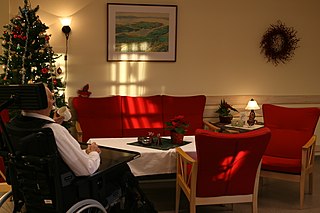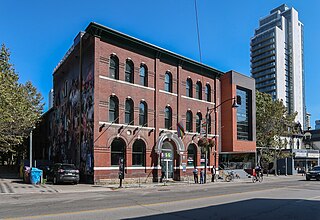Related Research Articles

AARP, formerly the American Association of Retired Persons, is an interest group in the United States focusing on issues affecting those 50 years old and older. The organization, which is headquartered in Washington, D.C., said it had more than 38 million members as of 2018. The magazine and bulletin it sends to its members are the two largest-circulation publications in the United States.
The Arab Community Center for Economic and Social Services (ACCESS) is a human services organization committed to the development of the Arab American community. ACCESS helps low-income families, as well as newly arrived immigrants adapt to life in the United States. Its goal is to foster a greater understanding of Arab culture in the U.S. and in the Arab world. ACCESS provides social, mental health, educational, artistic, employment, legal, and medical services.

An assisted living residence or assisted living facility (ALF) is a housing facility for people with disabilities or for adults who cannot or who choose not to live independently. The term is popular in the United States. Still, the setting is similar to a retirement home, in the sense that facilities provide a group living environment and typically cater to an older adult population. There is also Caribbean assisted living, which offers a similar service in a resort-like environment.

Beacon Hill is a historic neighborhood in Boston, Massachusetts, United States. It is also the location of the Massachusetts State House. The term "Beacon Hill" is used locally as a metonym to refer to the state government or the legislature itself, much like Washington, D.C.'s Capitol Hill does at the federal level.

Elderly care, or simply eldercare, serves the needs of old adults. It encompasses assisted living, adult daycare, long-term care, nursing homes, hospice care, and home care.
The Clubhouse model of psychosocial rehabilitation is a community mental health service model that helps people with a history of serious mental illness rejoin society and maintain their place in it; it builds on people's strengths and provides mutual support, along with professional staff support, for people to receive prevocational work training, educational opportunities, and social support. The model was created by Fountain House, one of the prime settings for what would, in the space of forty years, become the type specimen of the clubhouse model. Its validity is moderated and approved by Clubhouse International.

A retirement community is a residential community or housing complex designed for older adults who are generally able to care for themselves. Assistance from home care agencies is allowed in some communities, and activities and socialization opportunities are often provided. Some of the characteristics typically are: the community must be age-restricted or age-qualified, residents must be partially or fully retired, and the community offers shared services or amenities.

The 519, formerly known as The 519 Church Street Community Centre, is an agency by the City of Toronto. A Canadian charitable, non-profit organization, it operates a community centre in the Church and Wellesley neighbourhood of Toronto, Ontario, Canada. The 519 serves both its local neighbourhood and the broader lesbian, gay, bisexual and transgender (LGBTQ) communities in the Toronto area. The 519 defines its local neighbourhood by a catchment area that spans from Bloor Street to the north to Gerrard Street to the south, and from Bay Street in the west to Parliament Street in the east.
The Association of Jewish Aging Services (AJAS) was founded in 1960 as the North American Association of Jewish Homes and Housing for the Aging (NAJHHA). It was created and continues to function as the central coordinator for homes and residential facilities for Jewish elderly in North America. Dr. Herbert Shore was the driving force behind the establishment of AJAS and was the organization's first president and its founding executive vice president.
A naturally occurring retirement community is a community that has a large proportion of residents over 60 but was not specifically planned or designed to meet the needs of seniors living independently in their homes.
A group home, congregate living facility, care home, adult family home, etc., is a structured and supervised residence model that provides assisted living and medical care for those with complex health needs. Traditionally, the model has been used for children or young people who cannot live with their families or afford their own homes, people with chronic disabilities who may be adults or seniors, or people with dementia and related aged illnesses. Typically, there are no more than six residents, and there is at least one trained caregiver there 24 hours a day. In some early "model programs", a house manager, night manager, weekend activity coordinator, and four part-time skill teachers were reported. Originally, the term group home referred to homes of 8 to 16 individuals, which was a state-mandated size during deinstitutionalization. Residential nursing facilities, also included in this article, may be as large as 100 individuals in 2015, which is no longer the case in fields such as intellectual and developmental disabilities. Depending on the severity of the condition requiring one to need to live in a group home, some clients are able to attend day programs and most clients are able to live normal lifestyles.

The Alliance for Retired Americans (ARA) is a 501(c)(4) non-profit organization and nonpartisan organization of retired trade union members affiliated with the AFL-CIO, which founded it in 2001. The group's membership also includes non-union, community-based activists. Its predecessor organization was known as the National Council of Senior Citizens (NCSC).
The U.S. Centers for Disease Control and Prevention defines aging in place as "the ability to live in one's own home and community safely, independently, and comfortably, regardless of age, income, or ability level".

Lenox Hill Neighborhood House is a multi-service, community-based organization that serves people in need on the East Side of Manhattan and on Roosevelt Island. Founded in 1894 as a free kindergarten for the children of indigent immigrants and as one of the first settlement houses in the nation, Lenox Hill Neighborhood House is the oldest and largest provider of social, legal and educational services on Manhattan's Upper East Side. Each year, they assist thousands of individuals and families who range in age from 3 to 103, represent dozens of races, ethnicities and countries of origin and "live, work, go to school or access services" on the East Side from 14th Street to 143rd Street and on Roosevelt Island. Their clients include indigent families and the working poor who live in the East Side's housing projects and tenements or who travel to the Upper East Side to work in low-wage jobs such as cashiers, housekeepers, nannies and laborers; 10,000 seniors; and hundreds of mentally ill homeless and formerly homeless adults. They have five locations between 54th and 102nd Streets, offer programs at dozens of East Side locations; their headquarters is located on East 70th Street.

SCAN Health Plan (SCAN) is a not-for-profit, Medicare Advantage based in Long Beach, California. Founded in 1977, SCAN provides healthcare coverage to Medicare beneficiaries in California, Arizona, Texas and Nevada, serving more than 285,000 members. It is one of the largest not-for-profit Medicare Advantage plans in the country. SCAN Health Plan is part of SCAN Group.

Isabella Geriatric Center is a non-profit, nonsectarian organization that has provided residential and community-based services for elderly residents of New York City since 1875. The main campus is located in the Washington Heights neighborhood of Manhattan at 515 Audubon Avenue at the corner of 190th Street.

Founded in 1965, the Chinese-American Planning Council, Inc. (CPC) is one of the largest non-profit providers of educational, social, and community services for Asian-Americans in the United States. It now services over 8,000 people daily through some 50+ programs at over 30 locations citywide. It administers early childhood, school-age child care, youth, community, workforce development, and senior services. Its mission is to serve the Chinese-American, immigrant, and low-income communities in New York City by providing services, skills, and resources towards economic self-sufficiency.
HelpAge India is an Indian organization focused on the concerns of elders and support geriatric initiatives. Established in 1978, The aim is to serve disadvantaged elders in a holistic manner, enabling them to live active, dignified, and healthier lives.
Tri-Valley Transit is the public transportation provider primarily serving Addison, Orange, and north Windsor Counties in central Vermont. Tri-Valley Transit's mission is to enhance the economic, social and environmental health of the communities it serves by providing public transportation services that are safe, reliable, accessible and affordable.

Cycling Without Age (CWA) is a nonprofit organization founded in Copenhagen, Denmark in 2012. By 2020, this initiative had expanded into 50 countries, serving over 1.5 million people worldwide.
References
- 1 2 Nell Bernstein, Elder Villages Offer Independence Plus Community, Caring.com; updated Oct. 21, 2008; accessed 2013.05.17.
- 1 2 Robin Evans, Senior villages that help elderly stay at home come to West Coast, San Francisco Chronicle , Dec. 12, 2007; accessed 2013.05.17.
- 1 2 Philip Moeller, "Senior Villages Take Root as Movement Matures, U.S. News & World Report , January 28, 2011; accessed 2013.05.18.
- ↑ Constance Gustke, "Retirees Turn to Virtual Villages for Mutual Support", The New York Times, November 29, 2014, p. B4.
- ↑ The Village: A Growing Option for Aging in Place, Fact Sheet 177, AARP Public Policy Institute, 2010.
- ↑ Alex Pianin, Aging-in-place 'villages' seek further growth in Northwest [usurped] ", The Northwest Current, May 1, 2013, p. 1.
- ↑ Jane Gross, "A Grass-Roots Effort to Grow Old at Home", The New York Times , August 14, 2007; accessed 2013.05.17.
- 1 2 3 4 Haya El Nasser, 'Villages' let elderly grow old at home, USA Today, July 26, 2010; accessed 2013.05.17.
- 1 2 3 Jane Gross, "Aging at Home: For a Lucky Few, a Wish Come True" The New York Times, February 9, 2006; accessed 2013.05.17.
- 1 2 Paula Span, "Sharing a Table, and Much More", The New York Times, October 15, 2010; accessed 2013.05.17.
- 1 2 Barbara Whitaker, "These Days, 'Retirement Living' Can Mean Many Things", The New York Times, February 6, 2005; accessed 2013.05.17.
- ↑ Village to Village Network, "About VtV Network"; accessed 2013.05.18.
- ↑ Robert Weisman, "For some seniors, a cultural shift and a vital volunteerism", The Boston Globe, July 7, 2018.
- ↑ Paula Span, "‘We Need Each Other’: Seniors Are Drawn to New Housing Arrangements", The New York Times, Sept. 27, 2019 (updated Oct. 1, 2019); accessed Oct. 7, 2019.
- ↑ Emily A. Greenfield, Andrew E. Scharlach, Carrie L. Graham, Joan K. Davitt, and Amanda J. Lehning, A National Overview of Villages: Results from a 2012 Organizational Survey , Rutgers School of Social Work, Dec. 1, 2012.
- ↑ Susan Straight, "'Village' groups, home alterations help more elderly people keep the homes they love", The Washington Post, July 27, 2012; accessed 2013.05.18.
- 1 2 3 4 5 6 Howard Gleckman, It takes a village to keep some seniors at home", The Washington Post , February 9, 2010; accessed 2013.05.18.
- ↑ Carrie L. Graham, Andrew E. Scharlach, Roscoe Nicholson, and Catherine O’Brien, 2016 National Survey of US Villages [ permanent dead link ] University of California, Berkeley, Center for the Advanced Study of Aging Services & Mather LifeWays Institute on Aging, 2017.
- 1 2 3 Village to Village Network, "Frequently Asked Questions"; accessed 2013.05.18.
- 1 2 3 4 Niharika Mandhana, Growing Older in an Urban Village, The New York Times, August 15, 2011. accessed 2013.05.18.
- ↑ Caitlin McGlade, For elderly at home, it takes a 'village' Archived 2016-03-04 at the Wayback Machine , The Columbus Dispatch , August 30, 2010; accessed 2013.05.20.
- 1 2 Alex Pianin, Cleveland Park gym spotlights senior athletes in photo display [ permanent dead link ]", The Northwest Current, Feb. 27, 2013, p. 5.
- ↑ Tara Bahrampour, "Through a growing number of senior villages in the D.C. area, aging in place becomes easier, The Washington Post, Feb. 6, 2014.
- ↑ D.C. Office on Aging, "Senior Villages"; accessed 2015.10.27.
- ↑ Village to Village Network homepage; accessed 2015.04.20.
- ↑ Village to Village Network, "The 2014 National Village Gathering"; accessed 2014.09.10.
- ↑ "Beacon Hill Village".
- 1 2 3 4 5 6 7 8 9 McDonough, K. E., & Davitt, J. K. (2011). It takes a village: Community practice, social work, and aging-in-place. Journal of Gerontological Social Work, 54(5), 528-541.
- ↑ "Village to Village Network Moves Headquarters to St. Louis: Local Executive to Lead International Senior Resource Organization", press release, January 6, 2015